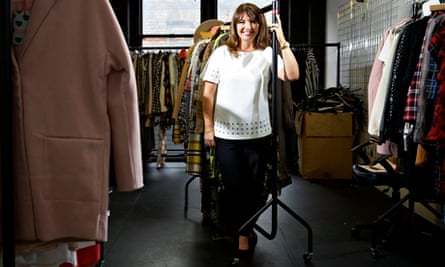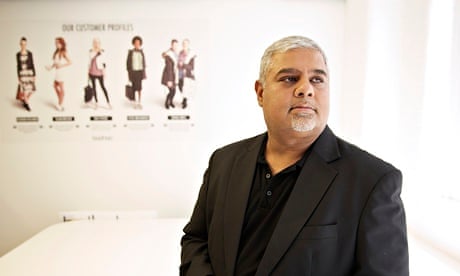With a cream leather lounger strategically placed under a map of the world labelled "the world is ours", the Manchester office of Boohoo founder Mahmud Kamani has the menace of a Bond villain's lair.
Kamani and his business partner Carol Kane are indeed plotting world domination but their weapon of choice is fashion website boohoo.com. With its £8 maxi dresses and £12 jeans the retailer is giving Primark a run for its money as its targets fashion-hungry 16- to 24-year-olds with limited finances.
"The map doesn't need dots," explains Kamani. "We're going to get everywhere." For many years Boohoo had been quietly going about its business in a rundown former mill. But the Kamani family sacrificed anonymity in March when they pressed the button on a stock market listing that earned them a fortune – and a large amount of scrutiny from potential investors.
The retailer has an impressive track record, having gone from a standing start in 2007 to profits of nearly £11m from sales of £110m in the year to the end of February. It has just completed the first of several phases of expansion planned for its Burnley warehouses, which will eventually be able to handle sales of £1bn. So far so Asos, the fast-growing fashion website, which until recently was a stock market darling.
After running a private business for decades, becoming a stock market pawn can be a shock for entrepreneurs used to doing what they think is best. Kamani is a refreshingly straight talker and reportedly told analysts at a recent meeting that Boohoo's mobile website was "shit". He is coy when asked about it and his PR offers that "it is being upgraded".
The listing has been a baptism of fire for the senior team, including Kamani's brother Jalal, who is trading director. After debuting at 50p the shares soared to 85p but are now back just below the offer price.
The company's office has the air of a start-up, with crowded banks of desks in every room, shabby paintwork and trendy twentysomethings running around looking busy. In the foyer a man is sorting hangers into giant cardboard boxes. With more than 500 staff the company has outgrown the warren and has just bought another building around the corner.
The IPO reaped £240m for the family and board members, but the pair have not been on a shopping spree. Kamani has a Rolls-Royce Phantom parked outside and Kane drives a shiny tank-like Land Rover, but they are not new. And although Kane is doing up an old house in Staffordshire she jokes it "would be nice to have a bathroom".
Indeed Kamani labours the point that Boohoo is not an overnight success but the culmination of decades of graft. "This is not an eight-year story; this is a family business that's been going for 30 years."
A key figure is Mahmud's elderly father Abdullah, who escaped war-torn Kenya in the 60s to start a new life in the north-west with his wife and four children. Abdullah's first venture was selling handbags on a market stall, but he went on to found what would become a successful family textile business, supplying high street names such as New Look and Primark, before he focused on Boohoo.
"It was a case of rags to riches for my dad," explains Kamani. "He bought his first Rolls-Royce 30 years ago and let my eldest brother Jalal drive it out of the garage. He adds: "My father is 80 and comes into work every day."
Kamani appears to have inherited his father's work ethic and is either on the phone or looking at messages on one of his two handsets when the conversation lulls. He is momentarily distracted by an email and elbows Kane. It turns out that the latest sales figures have come through and he is surprised how good they are. She quickly explains that a promotion has just kicked in.
"People have invested in us and that's an honour," he continues. "We work hard. We worked hard when we were on the market stalls; we work hard now. It's what we've always done. I don't have another hobby or life. I want to walk into my office an old man."
After proving useful in the runup to the flotation, the comparison with Asos stopped being favourable earlier this month, when Asos blamed the strong pound and heavy discounting for a massive profit warning. The alert spooked investors, wiping as much as 40% off Asos's share price on the day and pulling Boohoo down with it.
It has led to a dramatic reappraisal of Asos's prospects, with Morgan Stanley analyst Anisha Singhai slashing her price for the stock from £40 to £25. (Asos suffered a further setback this weekend when a fire at its Barnsley warehouse forced it to stop taking orders.) On the surface the fashion websites have a lot in common, but there are key differences. While Asos carries 75,000 products, including 1,000 third-party brands, Boohoo stocks just 9,000 of its own clothing lines.

Kane, who is co-chief executive of the listed group, says the focus on own-brand is key. "We're in full control of our pricing structure all the way through," she says. "If you want to promote your own brand you haven't got any restrictions."
After working together for more than 20 years – Kane set up its design team in 1993 – the co-chief executives are prone to interrupting each other. "Any business doing international trade will have challenges on foreign exchange," continues Kamani. "But we only sell Boohoo, so we command the price."
Unusually Boohoo buys very small quantities of stock, 300-500 pieces at a time, with one in four orders then repeated. "Because this is an e-commerce business you've got to be fresh all the time," says Kane. "A traditional retailer might buy three or four styles but we'll buy 25. That way we've covered off the overall volume required and the one that really works we'll get back into."
At the moment Boohoo has seven major markets, including the UK, US and France, although it ships to more than 100. Despite the breakneck growth of recent years the cream lounger still looks pristine. Kamani says he never uses it for brainstorming sessions. "Once I was really tired and actually laid on it and tried to rest," he says. "But every fucker kept walking through the door because I always say my door's open."

Comments (…)
Sign in or create your Guardian account to join the discussion